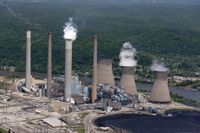On Monday, September 29, 2025, the Trump administration unveiled a sweeping set of policies aimed at reviving the American coal industry, pledging billions in investments, deregulation, and a dramatic expansion of coal mining on public lands. The move, which top officials say is designed to help the United States "win the AI arms race with China," has sparked fierce debate across the political spectrum and drawn sharp criticism from environmental advocates.
During a high-profile gathering in Washington, D.C., officials from the Department of the Interior, the Environmental Protection Agency (EPA), and the Department of Energy (DOE) stood before a backdrop of coal miners and lawmakers from coal-rich states. They outlined a plan to open 13.1 million acres of federal land for new coal development, lower royalty rates for mining companies, and invest $625 million in modernizing and recommissioning aging coal power plants. According to Inside Climate News, this represents one of the largest coal land releases in recent history, tripling previous benchmarks set by recent legislative acts.
Interior Secretary Doug Burgum, who led Monday’s announcements, described coal as an industry "under assault," but one that remains central to America’s economic and national security future. "U.S. coal power plants are the cleanest coal plants in the world," Burgum asserted, arguing that reinvesting in coal would allow the U.S. to outcompete China and meet soaring energy demand forecasts, particularly from data centers fueling artificial intelligence. He announced that the federal royalty rate for coal mined on public land would drop from a floor of 12.5 percent to a new ceiling of 7 percent, a change he said would "strengthen our economy, protect national security, and ensure that communities from Montana to Alabama benefit from good-paying jobs."
But the financial implications of these changes are already causing concern in states like Wyoming—the nation’s largest coal producer. The Interior Department recently announced an auction of 3,500 acres of public lands for new coal mines there. Because Wyoming typically splits coal royalty revenues with the federal government, the state could lose out on $50 million annually under the new, lower royalty rate, according to a state-authored analysis cited by Inside Climate News.
EPA Administrator Lee Zeldin followed with his own set of deregulatory measures. Zeldin pledged to repeal dozens of existing rules, delay limits on coal ash wastewater discharges from power plants, and reexamine the Regional Haze program that governs power plant pollution. "In the course of one year, we will do more deregulation at the EPA than entire federal governments have done across all federal agencies across entire presidencies," Zeldin declared, as reported by Inside Climate News.
The DOE’s $625 million investment package, announced by Secretary of Energy Chris Wright and Undersecretary Wells Griffith, is designed to keep coal plants operating and electricity prices low, officials say. The funds are allocated across several initiatives: $350 million for recommissioning and retrofitting plants, $175 million for rural community projects, $50 million for wastewater management, $25 million for dual firing retrofits, and $25 million for gas cofiring systems, according to Common Dreams. Wright was unequivocal: "Beautiful, clean coal will be essential to powering America’s reindustrialization and winning the AI race," he said. "These funds will help keep our nation’s coal plants operating and will be vital to keeping electricity prices low and the lights on without interruption. Coal built the greatest industrial engine the world has ever known, and with President Trump’s leadership, it will help do so again."
Supporters of the administration’s plan, especially in coal-dependent states, were quick to praise the measures. West Virginia Governor Patrick Morrisey called the investment a "major victory" for his state and the nation, highlighting West Virginia’s "50 by 50" energy policy that relies heavily on coal and gas. "By upgrading our existing coal-fired power plants to run cleaner and more efficiently, we can lower energy prices for consumers and build the generating capacity we need to compete with China, all while supporting the hardworking West Virginians who work in our coal and gas industries," Morrisey said, according to West Virginia News. Senator Jim Justice, also of West Virginia, echoed this optimism, calling the $625 million investment a "massive win for our miners, our families, and America’s energy independence."
Yet the administration’s coal push has drawn a firestorm of criticism from environmentalists and public health advocates. The Sierra Club’s Beyond Coal campaign director, Laurie Williams, denounced the plan as "a transparent wealth transfer from everyday Americans, who are already making tough decisions at the kitchen table, to the millionaires that run the fossil fuel industry." Williams added, "If Chris Wright, or anyone in Donald Trump’s administration, truly cared about bringing down the cost of electricity, they would be investing in affordable clean energy instead of taking a sledgehammer to the progress our country has made."
David Arkush, director of Public Citizen’s climate program, was equally blunt: "President Trump’s coal giveaway is exactly the wrong direction for the country. It is clear that solar, wind, and battery storage will provide nearly all affordable, clean energy in the near future, and expensive, dirty coal will be a relic of the past." According to Common Dreams, Arkush argued that the administration’s efforts to "block renewables and keep fossil fuels on life support only hurts Americans," resulting in higher energy costs, increased pollution, and missed opportunities to build up domestic manufacturing for future energy technologies.
Camden Weber, a climate and energy policy specialist at the Center for Biological Diversity, suggested that the administration’s policies prioritize "data center profits over Americans’ access to clean air, water, and affordable energy." Weber warned, "Trump’s order fabricates yet another 'energy emergency' to keep filthy coal plants online and fueling massive, energy-sucking data centers. He and his ultrarich friends will cash in while the public and our planet pay the price. The damage to our climate will be immense and unforgivable."
Jill Tauber, vice president of litigation for climate and energy at Earthjustice, argued that "expanding mining and spending taxpayer money on burning coal, while rolling back vital health protections, will only exacerbate the deadly pollution and rising electricity bills that communities are facing across the country." She pledged that Earthjustice would continue to challenge the administration in court.
Despite the regulatory and financial support from the Trump administration, energy forecasters remain skeptical about coal’s long-term prospects. As Inside Climate News reported, coal has been on a decades-long decline as cheaper natural gas and renewables have increasingly dominated the energy market. Even with relaxed regulations, "uncertainty is going to mean that it’s now a riskier investment" to build new coal power plants, said Josh Linn, a senior fellow at Resources for the Future.
Critics also point out that while the administration frames coal as key to competing with China, the U.S. Energy Information Administration estimates that China installed almost ten times as much new renewable energy last year as it did coal. Racheel Hamby, policy director at the Center for Western Priorities, summed up the skepticism: "Donald Trump and Doug Burgum are trying to build a bridge to the 19th century. There’s no such thing as clean coal."
As the administration pushes forward with its coal agenda, the nation finds itself at a crossroads—torn between the promise of industrial revival and the perils of environmental decline. The stakes couldn’t be higher, and the debate is far from over.

